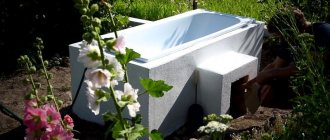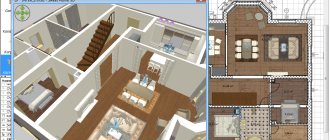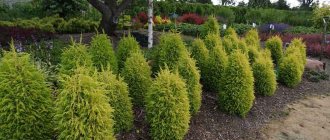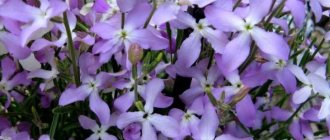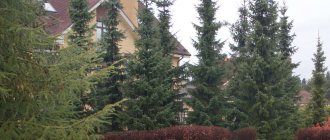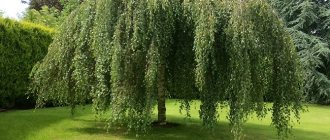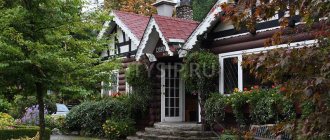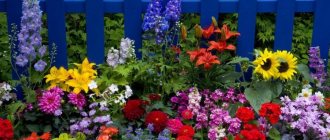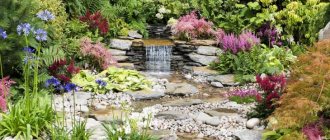Conifers are beautiful at any time of the year. They are good individually and in a group, combined with most garden plants, suitable for alpine slides, creating hedges, and decorating flower beds. Read about autumn planting and caring for conifers.
In order for a coniferous plant to develop well and grow quickly, you need to plant it correctly. Planting thuja in the fall is possible until the coldest weather. The same applies to other conifers - they are all sold in containers, so they take root well and have time to get stronger even when planted in early November.
Choosing a place to plant conifers
Conifers are not the most demanding representatives of the flora, but they also have preferences.
Plants will develop correctly in well-lit areas or in slight shade.
In hot climates, it is better to plant conifers in partial shade - then they will retain the color characteristic of the variety and will look healthy. In the scorching sun they turn pale and stretch out.
Conifers develop a large root system and do not like competition, so they are not recommended to be planted next to large trees.
Conditions to be created before planting
Lighting
Coniferen (both an established cutting and an adult tree) in terms of light “puts forward” requirements identical to tropical flowers: it likes there to be a lot of light and it is bright, but the rays do not fall directly on the branches.
But this does not mean that the pot of coniferene needs to be kept in the shade. In winter, keep it in the sun (at this time of year, even direct rays will not harm your coniferous pet). In summer, it is good to choose a western or eastern window sill for the plant - the southern one is also possible, but at lunchtime shade the juniper.
Temperature
This plant does not like excesses: in summer it does well if the room temperature does not rise above 25 degrees. In winter, it may freeze, but only a little - up to 13 degrees, no more.
The room with the conifer can be ventilated often, this will be beneficial for him - but the pot should not be in a draft.
If your open balcony is not blown by all the winds, you can move the plant here for the whole summer.
Soil and pot
The coniferous flowerpot loves eco-friendly pots: porcelain, ceramic (glazed), clay.
The soil for conifer is suitable for the following plan: peat + turf soil + sand + universal fertilizer (any purchased) + nitrophoska (about 200 g of this substance is used for one plant). In a word, the soil for juniper should be light and nutritious.
By the way, there is also a special primer for conifers on sale, here’s what a package with it might look like:
And don't forget about drainage!
Your actions when landing:
Soil for coniferous trees and shrubs
On wet and heavy clay, conifers will most likely turn yellow and drop their needles.
The ideal option for the evergreen prickly inhabitants of the garden would be light, organic-rich, well-drained soil with a groundwater level no higher than 120 cm. Rain and melt water should not accumulate under conifers.
All conifers love acidic soil. Moreover, they are able to independently acidify the soil in the feeding zone - the falling needles contain acids, which makes conifers ideal neighbors for hydrangeas.
Thuja mix planting and care in open ground
Adele, well, you not only water, but also feed your juniper? If you cut down a juniper, you won’t live even a year after that. (Wales). I associate the smell of juniper with a coniferous forest.
And this is not surprising. We have never been able to find out where this fatal belief about juniper came from.
Soft (in most species) needles of various colors, delicate aroma, undemanding to growing conditions - these are the reasons why gardeners and designers are attracted to junipers. Junipers are planted in sunny places. In the shade they can grow shapeless and loose and lose all their decorative advantages.
Source
Landing technology
After choosing a location, you can begin planting. Thuja, pine, juniper, fir - planting and care in open ground for these plants are the same:
- the size of the pit should be at least twice the volume of the container in which the plant is located;
- It is better to add drainage to the bottom with a layer of about 20 cm;
- It is recommended to fill the hole with a soil mixture of garden soil, humus and sand 3:2:1;
- transferring a seedling from a container to a permanent place must be done carefully and under no circumstances should the root collar be buried when planting;
- After planting, the conifers are watered abundantly and then the level of humidity is monitored, which should be sufficient, because the plant grows its root system.
Advice. To make the plant take root faster, add Heteroauxin or any other root growth stimulator to the watering water.
The tree trunk circle should be generously sprinkled with any loose material (mineral chips, pine needles, leaves). The mulch layer should be no thinner than 5 cm.
Coniferous mix for the room
Indoor conifers are coniferous plants that are not adapted to wintering outside and low temperatures. Their homeland is often subtropical. In our conditions, they do not tolerate cold winters, so they are grown in greenhouses or on window sills.
Dwarf and creeping varieties are suitable for home growing on a windowsill. They require certain maintenance conditions, compliance with planting and care rules. Namely - fresh humid air, watering, drainage, average illumination.
Indoor conifers include cypress and home cypress, Japanese cedar, indoor spruce and arborvitae.
Cypress and indoor cypress
These two plants differ in the color of their needles. Cypress - has light green needles. Home cypress – dark green. The needles of young plants are needle-shaped. With age, the needles become scaly.
Unlike many other conifers, cypress grows on sunny windowsills. It does not like dry air, so if there is a hot radiator under the window, you need to spray the plant several times a day.
Does not tolerate movements and even turns in one place.
Therefore, it is better not to “rotate” the cypress tree, but to grow it stationary. And replant less often, only if the plant has really grown and does not fit in the old container.
In the summer, you can move the cypress tree outside, into partial shade, given that the plant does not tolerate temperatures above +25°C. In summer it can be watered abundantly. It must be brought into the room no later than the temperature drops below +10°C.
Japanese cedar or Cryptomeria japonica
This small tree is very decorative. Its young needles are flat and soft to the touch. With age, the needles will become awl-shaped and stiffer.
In autumn, Japanese cedar will change the color of its needles - they will turn reddish. This is a signal that the plant is expecting winter.
Japanese cedar grows and develops well if its temperature is reduced in winter, the container is moved to a cool windowsill, or moved to a cooler room.
It loves moisture very much, so daily watering and spraying are required.
It is demanding on the nutritional value of the soil, so every year the soil is partially changed - the top layer is removed and new, fresh soil is added.
Tuevik or tuyopsis
The needles of the thuevika look like a small, leathery, flattened leaf. Loves shade and coolness, grows well in diffused lighting of the corridor.
Araucaria or indoor spruce
The decorative effect of this tree is ensured by its pyramidal crown, which is formed even when grown in an indoor pot. The needles are short, rather rigid, triangular at the base. Winter temperatures should not rise above +16 °C. In summer – up to +25°С.
The plant does not like direct sunlight. Therefore, in summer it is placed outdoors in the shade, and in winter – away from the window. It grows well even in a dimly lit corridor. Does not tolerate dry air, requires spraying. Loves spacious containers and does not grow well in cramped pots.
Conifer care
Seedlings planted in autumn will have to be watered at least once a week until the cold weather, if the autumn is dry. Plants should overwinter in moist soil, because they will constantly evaporate water and will die of thirst in dry soil.
Starting in spring, you need to regularly use special fertilizers, for example, Fertika Kristalon. Fertilizers will make the needles greener, more fragrant, help the tree fight the heat, and speed up rooting.
Where can I get small juniper
In most cases - buy. Especially often, such plants begin to be offered in flower shops and even supermarkets on the eve of the New Year. They are even decorated with miniature balls and artificial snow, imitating a Christmas tree. It is especially interesting to find conifer mix on sale. These are different varieties of indoor juniper. By purchasing everything at once, you can create a unique decorative composition at home.
However, if you have never seen such plants for sale, and want to grow indoor conifer right now, you can go to the nearest forest or park, find this plant and break off a stalk. It takes root well at home. And then just put the baby in the potty and care for him as written above.
A garden center expert will tell you more about rooting a juniper branch:
Well, it’s even easier to find a ready-made bush in the forest, dig it up and bring it home. True, such a “feint” will only take place in the northern latitudes - it is there that this prickly, aromatic plant can be found in the wild.
Formative pruning
Conifers are pruned to give them the desired shape and remove dried and broken branches. It is better to do pruning in early spring - after it many lush and healthy shoots are formed.
Important. Conifers grow slowly, so they do not have to be pruned often. You need to wear gloves to avoid scratching your hands. In addition, yew, thuja and juniper secrete caustic juice.
Trees can be shaped into spheres, cones, and cubes. Juniper and thuja are especially easy to shape. Pine does not tolerate pruning well - it is better to simply pinch out its shoots.
Shelter for the winter
After the first snow falls, a seedling planted in the fall should be covered with non-woven material, which will protect the young conifer from winter sunburn. Conifers need sunlight all year round, so the material should be light, not black.
By the second wintering, the plants have already taken root well and no longer need shelter. Mature junipers and thujas with a vertical crown shape are not tightly tied with twine for the winter so that they do not lose their shape under the weight of snow. Spreading trees - spruce and pine - are shaken periodically in winter, if possible, to remove snow from the branches.
Do you have coniferous plants at your dacha? Tell us in the comments how you use them in design and how you care for them. If you are just planning to plant conifers, watch a short master class from specialist Becker, who will clearly show how to plant coniferous trees and shrubs correctly.
Which coniferous plants to choose for the garden
The choice of coniferous plants depends entirely on the idea that the gardener decided to implement on the site. If you are setting up a rock garden, then tall plants are not appropriate in such a composition, so choose dwarf species and dwarf trees that do not grow more than 40-50 cm in height.
Low-growing conifers for alpine slides:
- Scaly juniper Blue Carpet - bluish-green needles densely cover spreading branches. The height of the plant ranges from 30 to 40 cm. The branches are spreading and lush. The variety winters well at -40C.
- Horizontal juniper Blue Chip is a spectacular compact dwarf tree up to 20-30 cm high for decorating rocky gardens, dry streams, and Japanese-style compositions. The variety overwinters at -40C without damage or problems.
- Juniper horizontal Prince of Wales - the width of the branches of this plant extends to 1.5 m, and the height is limited to 15 cm. An excellent variety for decorating the slopes of rocky gardens and rock gardens.
- Juniperus horizontalis Limeglow - the light yellow-green needles of this variety contrast perfectly with the green and blue dwarf trees. An original variety for creating a color accent.
- Juniper scaly Blue Star is a charming 20 cm tall plant to create an accent in a rock garden or rock garden.
To create figured hedges, tall plants with needles of different colors are used. Varieties with pyramidal and columnar crowns look especially impressive in hedges: juniper virginiana Kanaherti; Lawson Stardust cypress; yew medium Hixie; Thuja occidentalis Sunkist; Rock juniper Blue Arrow. Coniferous trees are suitable for single plantings: pine, spruce, fir, cedar and others.


